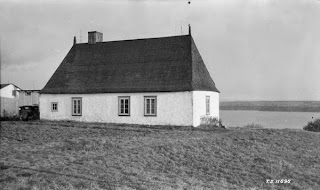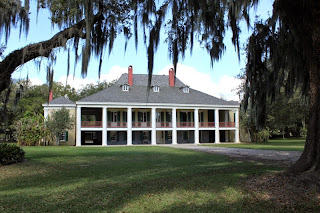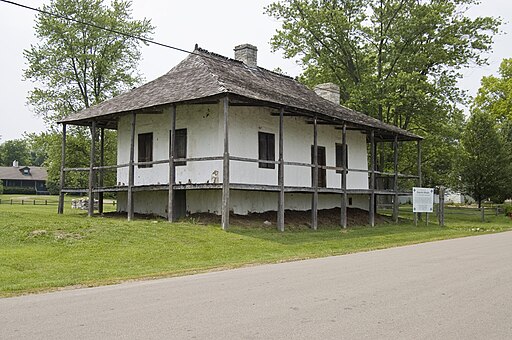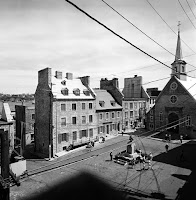As an overview to housing design in Nouvelle France, three regions existed: Canada, Illinois, and Louisiane. In each of these three regions, roof lines or styles were the most distinguishing climatic adaptation. In Canada, roofs were steeply pitched (55 degrees from horizontal) to sluff-off snow.

Eves were reduced to give less area for ice buildup, which causes melted snow to puddle until finding a hole in which to penetrate the living space.

In Illinois and Louisiane, snow wasn't the problem. Rain and humid heat were. Roof pitches more closely reflected those in France while wide, shed-roofed galleries were added. These galleries kept the rain well away from the walls of the house while also providing shade for the walls. Gaps between the tops of the attic walls and the undersides of these wide, overhanging roofs produced venturies which might have been helpful in cooling the houses if the habitants could stand the stuffiness of not having open windows or doors. In addition, in Louisiane the bottom floors of houses were elevated so air could flow beneath the houses to help cool them and to reduce the moisture that would otherwise quickly rot sills and floor joists. Louisiane’s best colonial housing is reflected in the lovely plantations along the bayous.

The heavy timbers and beams used in all three locations provided heat sinks that helped make these houses habitable. The wood absorbed heat all day and gave it off at night, thereby moderating inside temperatures. In the North, that heat was from the fireplace. In the South, that heat was the mugginess of summer.
Habitants to Nouvelle France brought with them housing designs from their native regions. Most habitants to Nouvelle France (Canada) came from the regions of Normandy, Brittany, the Perigord and Dordogne (Moogk 1977:22). These are rural regions, with Normandy retaining the housing designs of its Danish ancestry, that Viking long house design reflected in their cavernous farmhouses which had been adapted to the region's shortage of timber. Thus, habitants from Normandy built houses in Canada like those in Normandy which are like those in most of Danish-influenced Europe, their design being somewhat similar to the Iroquois Confederacy's "longhouse." Whether the house was constructed of timber in poteaux en terre [posts in the ground] 
or poteaux en sol [posts mortised in a sill timber]  filled in with colombage pierroté (stone and mortar) or colombage bousillé (a cheaper fill of crushed stone, shells, or moss and mud), the house was basically longer than wide by the ratio of 2-to-1 with either a central fireplace or with a fireplace at each end of the structure, and with no partitioning inside. This architectural style was known in France as "Norman half-timbered," and it was similar in feel to the palatial stone halls of the aristocracy. But the large, open expanse was difficult to heat in France, and nearly impossible to heat in Nouvelle France.
filled in with colombage pierroté (stone and mortar) or colombage bousillé (a cheaper fill of crushed stone, shells, or moss and mud), the house was basically longer than wide by the ratio of 2-to-1 with either a central fireplace or with a fireplace at each end of the structure, and with no partitioning inside. This architectural style was known in France as "Norman half-timbered," and it was similar in feel to the palatial stone halls of the aristocracy. But the large, open expanse was difficult to heat in France, and nearly impossible to heat in Nouvelle France.
The first habitants to arrive in Nouvelle France built nearly exact copies of houses in their native regions, but within a generation the abundance of locally available timber produced a distinctively Canadian style: pieces-sur-pieces, or upright posts grooved to receive short, horizontally-laid timbers, a style that would later be known as "Red River Frame." 
This fully timbered house resulted in superior insulation against the long, cold Canadian winters. "Red River frame construction had its origins both in Europe and New France. It evolved from a half-timber house which had wooden verticals fairly close together and the space between filled with mortar and stones. This fared poorly and the mortar and stones were replaced with horizontal wooden inserts which were not water tight and shrank and warped over time. The solution was to have the short horizontal tongue and grooved into the vertical studs. A harder, water resistant wood was used as a base sill. No nails were used on these interlocking joints with wooden pegs as anchors. Wood was abundant, as the river banks were bordered by maple, elm, oak, and pine. The roofs were thatched with hay from the plains and mud from the river bank. The river mud was used for making plaster, finishing chimneys and fireplaces. Dividing walls could be made of poplar trunks, lathwork and plaster.] But its primary advantage was that "a single man with a few portable tools could do most of the work of building himself" (Moogk :34) and it appears that this style continued on into the Mid-Continent with the habitants as they settled in the Pays Illinois (see plan and elevation of Red River Frame LePage House noted in Prairie du Pont, IL, by the WPA and diagramed in [Walthall 1991:120] prior to its demolition in 1972). In addition, in Illinois, poteaux en sol construction was retained until some time after American possession of the territory.
If roofs were not of thatch, they were most often overlapping boards on top of a layer of tongue-in-groove boards laid on top of the rafters. This technique also aided in keeping out the wind and weather; later shingles replaced thatch.
 However, shingles were soon banned in the cities of Nouvelle France because they proved such a fire hazard. Stone gables were required between townhouses and ladders were attached to roofs to aid firefighting.
However, shingles were soon banned in the cities of Nouvelle France because they proved such a fire hazard. Stone gables were required between townhouses and ladders were attached to roofs to aid firefighting.
 "The attic story may have provided additional living space . . . a knee wall at least two pieds (French foot measurement) high above the second floor ceiling joists allows for large, usable attics . . . if it were too cold up there in winter for the owner, it was deemed sufficiently warm for children or servants (Moogk: 27)" (See Figure 7-13. Pierre Martin/Nicholas Boismenue House in Prairie du Pont, constructed in ca. 1790 [Walthall: 116]. Restoration of the Martin/Boismenue House now employs venturies and open attic space to facilitate heat loss in the humid American Bottom).
"The attic story may have provided additional living space . . . a knee wall at least two pieds (French foot measurement) high above the second floor ceiling joists allows for large, usable attics . . . if it were too cold up there in winter for the owner, it was deemed sufficiently warm for children or servants (Moogk: 27)" (See Figure 7-13. Pierre Martin/Nicholas Boismenue House in Prairie du Pont, constructed in ca. 1790 [Walthall: 116]. Restoration of the Martin/Boismenue House now employs venturies and open attic space to facilitate heat loss in the humid American Bottom).
Regardless of construction technique, Canadians smeared a covering of lime or whitewash over roughcast mortar and timbers, effectively masking the materials used--colombage, stone, or timber. "The people of the period did not value a look of raw wood or stone--just as they did not accept the appearance of a natural wood finish on furniture. . . . The lack of paint or whitewashed plaster was a sign of poverty, which even the poorest habitant found unacceptable. Under no circumstances would they have incised the joints between stones . . . that procedure would have accelerated the destruction of the wall and soft-lime mortar by water and frost (Moogk: 95)."
As most of the habitants came to Canada prior to 1700, they brought with them in their resettlement throughout Nouvelle France the large open room, or two rooms with a few furniture items to relieve its starkness. When the Sun King’s influence on architecture and furnishing began to wane, it was accompanied by a change in manners . . . "People want their ease and comforts, to suffer less from cold, to be able to seclude themselves from their train of domestics and from troublesome outsiders, to be able to go conveniently from one part of the house to another, to find at meal times their table prepared in a room devoted to the purpose (de Félice II 1920:23). Clients no longer demanded from their builder a large hall with portable partitions or screens, but begin to install permanent partitions, and, therefore, separate rooms are set apart for specific purposes--bedrooms, common rooms or parlors with separate entrances, and other rooms as the wealth of the family allowed. This adaptation was followed in Nouvelle France, as well, and the majority of houses now include a kitchen--dining room, parlor and a separate bedroom for the master; children normally slept upstairs in the attic.
Residents of palaces and large farmhouses utilized screens to partition smaller spaces or "rooms," especially in front of fireplaces. The screen would reflect back the heat of the fireplace and keep the sitter somewhat cozy "Two folding screens, each of six "doors," of red serge with gilt nails, struggle as best they can against the draughts;" (de Félice II 1920: xix)

In the beginning the cavernous dwellings seldom had partitions, other than a small corner turned into a closet (laiterie) for the chamber pot (Lessard and Marquis 1972:222). All family activities took place in the common room, which in the early days of the colony occupied the whole of the ground floor. Bedrooms, spaces like the cabinets in palaces, were made by the construction of pinewood partitions at the end of the 17thCentury, and the parlor was partitioned off from the common room at the end of the 18thCentury.
This post links to The Scoop 170 via Cedar Hill Farmhouse.
BIBLIOGRAPHY
DeFélice, Roger. 1920 Little Illustrated Books on French Furniture II: French Furniture Under Louis XIV. Translated by F. M. Atkinson. Frederick A. Stokes Company, New York.
Lessard, Michel and Marquis, Huguette. 1972 Encyclopédie de la Maison Québécoise: 3 Siécles d'Habitations. Les Éditions de l'Homme Ltée, Ottawa.
Moogk, Peter N. 1977 Building a House in New France: An Account of the Perplexities of Client and Craftsmen in Early Canada. McClennand and Stewart Limited: Toronto, Ontario.
Walthall, John A. 1991 French Colonial Archaeology: The Illinois Country and the Western Great Lakes. University of Illinois Press, Urbana, Illinois.














